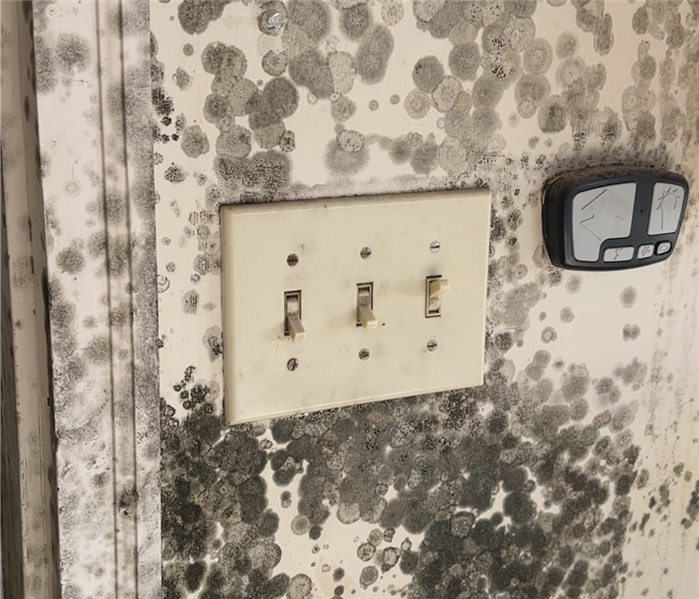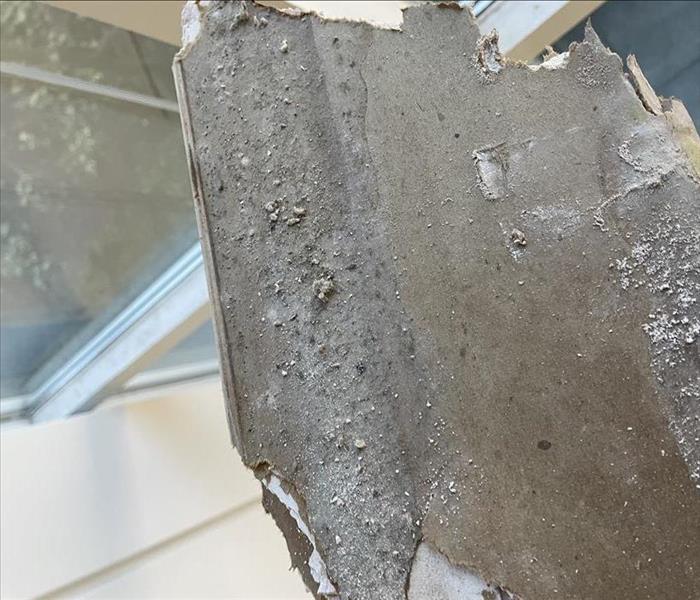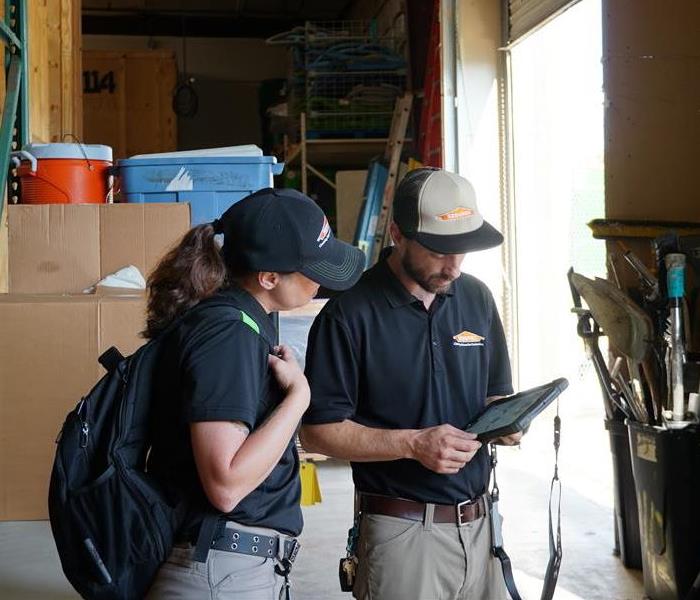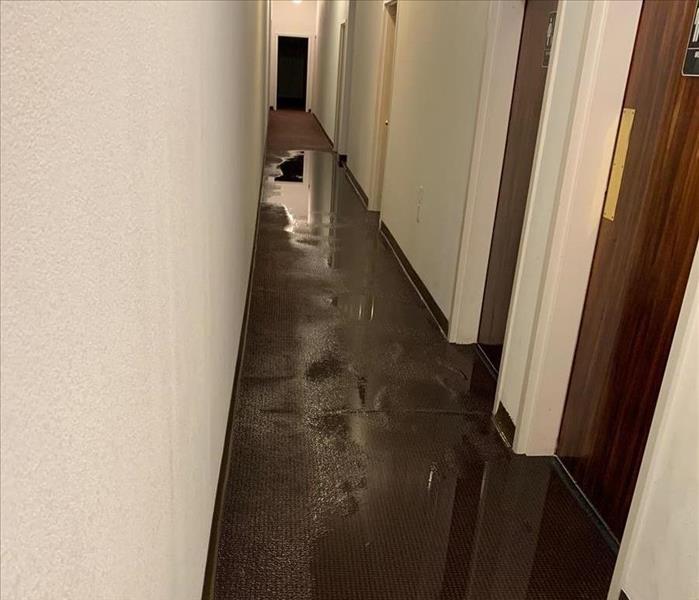Recent Posts
The importance of securing your property after a fire
12/4/2024 (Permalink)
Experiencing a fire can be overwhelming, and the aftermath often leaves homeowners feeling uncertain about the next steps. However, securing your property promptly is crucial for minimizing further damage and protecting your belongings. Here, we’ll explore why taking quick action is essential and how it can help you recover faster.
Preventing Further Damage
After a fire, your property is vulnerable to additional harm from weather, vandalism, or animals. According to the National Fire Protection Association (NFPA), U.S. fire departments respond to over 350,000 home structure fires annually, with the majority causing significant damage to the building’s structure and leaving openings exposed. Securing these openings—such as broken windows, doors, or damaged roofs—can prevent rain, wind, or pests from causing further deterioration. Using tarps and board-up services to seal openings immediately can also help maintain the structural integrity of your home while you plan repairs.
Protecting Against Theft and Vandalism
Once your home has been affected by a fire, it can become an easy target for theft or vandalism. Criminals may take advantage of broken windows or doors to steal valuable belongings or damage the property further. Securing your home with temporary fencing or boarding up doors and windows helps deter opportunistic thieves. In addition, installing temporary lighting around the property can increase visibility, making it less appealing for intruders to target your home.
Ensuring a Safer Environment
While firefighting efforts may extinguish visible flames, some areas of the structure could still pose safety risks. Unstable walls, ceilings, or flooring may collapse if not properly addressed. By securing the property, you minimize these risks, making it safer for restoration crews to assess and begin repairs. Experts recommend having a professional fire damage restoration team inspect the premises for any structural concerns and safely stabilize the building before allowing anyone inside.
Steps to Secure Your Property
Taking the right measures to protect your property is key to a faster recovery. Here are some essential steps:
- Board up damaged windows and doors to prevent unauthorized entry and weather damage.
- Install temporary fencing to secure the perimeter.
- Cover damaged sections of the roof with tarps to prevent water intrusion.
- Arrange for professional inspection and restoration services as soon as possible.
Quickly securing your property after a fire can help you regain peace of mind, minimize losses, and speed up the restoration process. For expert assistance, contact SERVPRO of South Central Fort Worth to ensure your home is protected and restored with care.
What does black mold look like?
11/13/2024 (Permalink)
 Spotting black mold early can save you time and money on repairs.
Spotting black mold early can save you time and money on repairs.
When it comes to mold in your home, identifying it early is crucial for minimizing damage to your property. One of the most concerning types of mold is black mold, often found in areas prone to moisture. Knowing what black mold looks like can help you catch it early and take the necessary steps for remediation. In this guide, we’ll walk through the characteristics of black mold and how to spot it.
What Is Black Mold?
Black mold, scientifically known as Stachybotrys chartarum, is a common household mold that thrives in damp or water-damaged areas. It typically appears in dark, hidden places such as basements, bathrooms, or areas affected by water leaks. Unlike other molds, black mold has a distinctive appearance, making it easier to recognize if you know what to look for.
Key Characteristics of Black Mold
Black mold stands out because of its distinct look, which can vary slightly depending on its growth stage and the surface it inhabits. Here are some of the key traits to look for when identifying black mold:
- Color: True to its name, black mold is usually black or very dark green. Sometimes, it may appear with shades of brown or gray.
- Texture: Black mold often has a slimy or wet texture, especially when it’s actively growing. Over time, it can become dry and powdery.
- Shape: It typically grows in irregular patches or spots, and these areas may spread quickly if left untreated.
- Location: Black mold tends to grow in areas that have been wet for at least 48 hours, such as ceilings, walls, and floors near plumbing leaks.
Where to Look for Black Mold
According to a 2022 report from the Environmental Protection Agency (EPA), homes with water damage or high humidity are at the highest risk for black mold growth. Areas to inspect for black mold include:
- Bathrooms, especially around showers and bathtubs
- Kitchens, under sinks or around appliances that use water
- Basements and crawl spaces
- Attics with roof leaks
- Windowsills and door frames
How to Confirm It's Black Mold
If you suspect black mold but aren’t entirely sure, consider having a professional mold inspection. DIY mold test kits can be useful for basic identification, but they often miss hidden mold or fail to give a clear answer. A professional inspection can confirm the type of mold and help with the appropriate steps for removal.
Final Thoughts on Identifying Black Mold
Spotting black mold early can save you time and money on repairs. By regularly inspecting your home for the signs mentioned above, you can take immediate action before the issue worsens. If you think you have black mold, reach out to SERVPRO® of South Central Fort Worth for expert mold remediation services.
Year-Round Water Damage Prevention: Tips for Every Season
10/16/2024 (Permalink)
 Our team is here to help you quickly and efficiently restore your home to its best condition.
Our team is here to help you quickly and efficiently restore your home to its best condition.
Water damage can happen at any time of the year, and each season comes with its own set of challenges. Whether it's heavy rains in the spring, summer storms, falling leaves in the fall, or freezing temperatures in the winter, knowing what to expect can help you protect your home from potential damage. At SERVPRO of South Central Fort Worth, we’re here to help you understand the seasonal risks of water damage and offer some practical tips to keep your home safe all year round.
Understanding the Risks of Water Damage Throughout the Year
Water damage isn't just a seasonal problem—it can occur at any time if you're not prepared. Let’s break down the different risks you might face each season and how you can be ready for them.
Spring: Watch Out for Heavy Rains and Flooding
Did you know that flooding is one of the most common natural disasters in the U.S.? Spring is known for its heavy rains and unpredictable weather, which can lead to flooding. When the ground is already soaked from melting snow, additional rain can easily overflow gutters and seep into basements and crawl spaces.
How to Prepare:
- Make sure gutters and downspouts are clear to prevent them from overflowing.
- Look for missing or damaged shingles and fix them before the next storm hits.
- If your basement is prone to flooding, a sump pump can be a great investment to keep water out.
Summer: Be Ready for Storms and Sudden Downpours
In Fort Worth, summer storms can come out of nowhere, bringing heavy rain and even causing flash floods. These sudden downpours can quickly overwhelm drainage systems, especially in urban areas, leading to localized flooding.
How to Prepare:
- Make sure all windows and doors are properly sealed to keep water from getting in during a storm.
- Make sure your yard slopes away from your home to prevent water from pooling near the foundation.
- Prepare a storm kit with essentials like flashlights, batteries, and non-perishable food in case of power outages.
Fall: Prevent Clogged Gutters and Roof Debris
Fall is when the leaves start to fall, and while they may look pretty, they can clog your gutters and downspouts, leading to water overflow and potential damage to your home’s foundation. Plus, autumn storms can cause roof damage, allowing water to seep in.
How to Prepare:
- Keep your gutters free of leaves and debris to prevent blockages.
- Cut back any branches that could break off during a storm and damage your roof or windows.
- After storms, check your roof for any signs of damage and repair as needed to prevent future water leaks.
Winter: Protect Against Freezing Pipes and Ice Dams
Winter brings its own set of challenges, like freezing temperatures that can cause pipes to burst and ice dams to form on your roof. When water freezes in your pipes, it expands, which can cause cracks or even bursts. Ice dams happen when melting snow refreezes at the edge of your roof, blocking proper drainage and causing water to back up under the shingles.
How to Prepare:
- Wrap pipes in unheated areas with insulation to protect them from freezing.
- Maintain a steady temperature in your home to help prevent pipes from freezing.
- Good ventilation in your attic can help keep your roof's temperature even and can prevent the formation of ice dams.
Stay Prepared with SERVPRO of South Central Fort Worth, Edgecliff Village
Understanding the different water damage risks each season can help you take steps to protect your home. By staying on top of home maintenance and being prepared for each season, you can avoid a lot of the stress and expense that comes with water damage.
If you ever do experience water damage, don’t hesitate to reach out to SERVPRO of South Central Fort Worth, Edgecliff Village. Our team is here to help you quickly and efficiently restore your home to its best condition.
Remember, a little preparation goes a long way in keeping your home safe from water damage, no matter what the weather brings!
Mold Growth in Humid South Central Climates: Prevention and Remediation
9/11/2024 (Permalink)
 If the mold problem is extensive, it’s best to call in professionals like SERVPRO.
If the mold problem is extensive, it’s best to call in professionals like SERVPRO.
Living in the humid South Central climates comes with its unique challenges, and one of the most persistent issues homeowners face is mold growth. The high humidity levels in states like Texas, Louisiana, and Arkansas create an ideal environment for mold to thrive. As a SERVPRO® professional, I want to share essential tips on preventing mold growth and effective remediation techniques to help keep your home safe and clean.
Understanding Mold Growth
Mold spores are naturally present in the air, and they only need moisture, warmth, and a food source to grow. In humid climates, moisture is abundant, making mold a common problem. Mold can grow on various surfaces, including wood, drywall, carpet, and insulation, often resulting in unsightly stains and potential structural damage to your home.
Prevention Tips
The best defense is a good offense. To avoid a mold problem all together, consider using some of these prevention tips:
- Control Humidity Levels: Maintaining indoor humidity levels below 60% is crucial. Use dehumidifiers, especially in basements and crawl spaces, to reduce excess moisture. Air conditioners also help control humidity while keeping your home cool.
- Proper Ventilation: Ensure your home is well-ventilated. Use exhaust fans in bathrooms, kitchens, and laundry rooms to expel moisture-laden air. Opening windows and doors when the weather permits can also improve air circulation.
- Fix Leaks Promptly: Water leaks from pipes, roofs, and windows can lead to mold growth if not addressed immediately. Regularly inspect these areas and fix any leaks or water damage promptly.
- Use Mold-Resistant Products: When renovating or building, consider using mold-resistant drywall, paint, and insulation. These products are designed to withstand high moisture levels and can help prevent mold growth.
- Regular Cleaning and Maintenance: Clean and dry any damp or wet areas within 24 to 48 hours. Regularly clean gutters to prevent water from seeping into your home. Inspect your HVAC system for any signs of mold and ensure it is properly maintained.
Remediation Techniques
If you discover mold in your home, it’s essential to address it quickly and effectively. Here are some steps for mold remediation:
- Identify the Source: Determine the source of moisture and address it to prevent further mold growth. This may involve fixing leaks, improving ventilation, or using dehumidifiers.
- Contain the Mold: Isolate the affected area to prevent mold spores from spreading to other parts of your home. Use plastic sheeting to seal off the area and maintain negative air pressure if possible.
- Remove Moldy Materials: Remove and dispose of any mold-infested materials that cannot be cleaned, such as drywall, insulation, and carpeting. Seal these materials in plastic bags before disposing of them to prevent the spread of mold spores.
- Clean and Disinfect: Clean non-porous surfaces with a mixture of water and detergent. Use a stiff brush to scrub the mold off surfaces like concrete and tile. After cleaning, disinfect the area with a mold-killing solution.
- Dry the Area: Ensure the area is thoroughly dried to prevent mold from returning. Use fans, dehumidifiers, and proper ventilation to speed up the drying process.
- Prevent Future Mold Growth: After remediation, take steps to prevent future mold growth by controlling humidity, fixing leaks, and maintaining proper ventilation.
By following these prevention and remediation tips, you can protect your home from the damaging effects of mold. Remember, if the mold problem is extensive, it’s best to call in professionals like SERVPRO who have the expertise and equipment to handle mold remediation safely and effectively. Keep your home mold-free and enjoy the comfort of a clean living environment.
Restoring and repairing fire-damaged walls and ceilings
8/14/2024 (Permalink)
 If you’re dealing with fire-damaged walls and ceilings, trust SERVPRO to restore your property with care and expertise
If you’re dealing with fire-damaged walls and ceilings, trust SERVPRO to restore your property with care and expertise
Experiencing a fire in your home or business is a traumatic event, leaving you with not only emotional distress but also the daunting task of cleaning up and restoring the damaged property. Among the various challenges, repairing fire-damaged walls and ceilings is crucial for ensuring the structural integrity and aesthetic appeal of your space. At SERVPRO®, we specialize in fire damage restoration and are here to guide you through the process, ensuring a seamless recovery and a return to normalcy as quickly as possible.
Assessment and Inspection
The first step in restoring fire-damaged walls and ceilings is a thorough assessment and inspection. This involves identifying the extent of the damage, including structural issues, smoke residue, and soot accumulation. Our team of experienced professionals uses advanced equipment and techniques to evaluate the condition of your property, ensuring no hidden damage is overlooked. Accurate assessment is critical for developing a comprehensive restoration plan tailored to your specific needs.
Smoke and Soot Removal
One of the most challenging aspects of fire damage restoration is removing smoke and soot from walls and ceilings. These residues can cause discoloration, corrosion, and persistent odors if not properly addressed. SERVPRO utilizes specialized cleaning agents and equipment to effectively remove smoke and soot, preventing further damage and ensuring a clean and safe environment. Our team is trained to handle different types of surfaces, from drywall to plaster, ensuring that all residues are meticulously cleaned.
Structural Repairs
Fire can compromise the structural integrity of walls and ceilings, necessitating repairs to ensure safety and stability. This may involve replacing damaged drywall, reinforcing weakened structures, and repairing or replacing insulation. Our skilled technicians are adept at performing these repairs, restoring your property to its pre-fire condition. We use high-quality materials and adhere to industry standards, ensuring durable and reliable results.
Odor Removal and Deodorization
Even after cleaning and repairs, lingering odors can be a persistent reminder of the fire. SERVPRO employs advanced deodorization techniques to eliminate these odors at the source. Using equipment such as thermal foggers and air scrubbers, we neutralize odor particles, ensuring a fresh and clean environment. Our comprehensive approach guarantees that your property not only looks restored but also feels and smells like home again.
Restoration and Finishing Touches
The final step in the restoration process is adding the finishing touches that make your space feel complete. This may include painting, wallpapering, and restoring decorative elements. SERVPRO takes pride in providing meticulous attention to detail, ensuring that the restored areas seamlessly blend with the rest of your property. Our goal is to leave your space looking even better than before the fire.
Why Choose SERVPRO?
At SERVPRO, we understand the complexities and challenges of fire damage restoration. Our team is committed to providing exceptional service, using state-of-the-art equipment and techniques to deliver the best results. We work closely with you throughout the process, ensuring clear communication and transparency every step of the way.
If you’re dealing with fire-damaged walls and ceilings, trust SERVPRO to restore your property with care and expertise. Contact us today to learn more about our fire damage restoration services and how we can help you get back to normal.
Revealing the Top 7 Hidden Places Mold Can Be Found in Your Home
7/17/2024 (Permalink)
 We uncover the top 7 hidden places where mold can be found in your home.
We uncover the top 7 hidden places where mold can be found in your home.
Mold is a common household problem that can lurk in various hidden places, often going unnoticed until it becomes a more significant issue. Identifying these hidden areas where mold can thrive is crucial for effective mold prevention and remediation. In this blog post, we'll uncover the top 7 hidden places where mold can be found in your home and provide tips for addressing and preventing mold growth in these areas.
Behind Walls and Wallpaper
Inside walls and behind wallpaper are ideal environments for mold growth, especially if there has been water damage or moisture intrusion. Mold can thrive in the dark, humid spaces between walls, making it challenging to detect until it spreads to visible surfaces.
Underneath Flooring
Mold can lurk underneath flooring materials such as carpet, laminate, or hardwood, particularly in areas prone to moisture, such as basements, bathrooms, and kitchens. Water leaks or spills can seep through flooring and create ideal conditions for mold growth beneath the surface.
Within HVAC Systems
HVAC systems provide the perfect breeding ground for mold, with dark, damp ductwork and evaporator coils providing ample moisture and organic material for mold spores to thrive. Mold growth within HVAC systems can spread mold spores throughout your home, leading to widespread contamination.
Inside Appliances
Appliances such as refrigerators, dishwashers, washing machines, and air conditioners can harbor mold growth if not properly maintained. Condensation, leaks, and food debris can create ideal conditions for mold to develop inside these appliances, often going unnoticed until the mold becomes visible or produces a musty odor.
Beneath Sinks and Cabinets
The space beneath sinks and cabinets is susceptible to mold growth, particularly in areas with plumbing leaks or poor ventilation. Damp conditions, combined with organic material from food waste or household cleaners, can create an ideal environment for mold to flourish in these hidden spaces.
Within Attics and Crawl Spaces
Attics and crawl spaces are often overlooked areas where mold can thrive. Poor ventilation, inadequate insulation, and roof leaks can create conditions conducive to mold growth in these hidden spaces. Mold in attics and crawl spaces can spread to other areas of the home if left unchecked.
Behind Appliances and Fixtures
Mold can hide behind appliances such as refrigerators, stoves, and washing machines, as well as fixtures like toilets and bathtubs. Condensation, leaks, and poor ventilation can create moist environments behind these appliances and fixtures, providing ideal conditions for mold growth.
Identifying and addressing hidden mold growth in your home is essential for maintaining a healthy indoor environment. By being aware of the top 7 hidden places where mold can be found and taking proactive measures to address moisture issues and improve ventilation, you can prevent mold from becoming a widespread problem in your home. If you suspect mold growth in any of these hidden areas, contact a professional restoration company like SERVPRO® for expert assessment and remediation services.
Glossary of Water Damage Restoration Terminology
6/17/2024 (Permalink)
Navigating the world of water damage restoration can be overwhelming, especially when faced with a plethora of technical terms and jargon. Understanding the terminology used in the field is essential for homeowners, restoration professionals, and insurance adjusters alike. In this blog, we've compiled a glossary of common water damage restoration terminology to help demystify the process and empower individuals to make informed decisions.
Water Damage & Mitigation
Water damage refers to any damage caused by water intrusion, such as flooding, leaks, or burst pipes. It can affect various materials and surfaces in a home, leading to structural damage, mold growth, and other issues.
Mitigation involves taking immediate action to minimize the impact of water damage and prevent further harm. This may include water extraction, drying, and implementing measures to protect against secondary damage.
Extraction & Drying
Extraction is the process of removing water from a property using specialized equipment such as pumps, extractors, and wet vacuums. Proper extraction is essential for preventing water damage from spreading and promoting drying.
Drying involves removing moisture from affected materials and surfaces to restore them to their preloss condition. This may include using air movers, dehumidifiers, and other drying equipment to facilitate the evaporation of moisture.
Dehumidification & Structural drying
Dehumidification is the process of reducing humidity levels in the air to prevent moisture-related issues such as mold growth and structural damage. Dehumidifiers remove excess moisture from the air, creating a drier environment for effective drying.
Structural drying focuses on removing moisture from building materials such as drywall, wood, and concrete. Proper structural drying is essential for preventing structural damage and mold growth in water-damaged properties.
Mold Remediation & Content restoration
Mold remediation involves the removal and cleanup of mold growth in water-damaged properties. This may include containment, removal of contaminated materials, and cleaning and disinfection to prevent mold recurrence.
Content restoration refers to the process of cleaning and restoring personal belongings and furnishings affected by water damage. This may include furniture, clothing, electronics, and sentimental items.
Salvageable & Non-salvageable
Salvageable items are those that can be cleaned, restored, and returned to their preloss condition after water damage. Restoration professionals assess the salvageability of items based on factors such as the extent of damage and material composition.
Non-salvageable items are those that cannot be restored or cleaned effectively after water damage. These items may be too severely damaged or contaminated to salvage and may need to be disposed of properly.
Understanding water damage restoration terminology is essential for effectively communicating and navigating the restoration process. Whether you're a homeowner dealing with water damage, a restoration professional providing services, or an insurance adjuster assessing claims, familiarity with these terms empowers you to make informed decisions and achieve successful restoration outcomes. By familiarizing yourself with this glossary, you can navigate the complexities of water damage restoration with confidence and clarity.
Keeping Your Home Dry: Tips to Prevent Exterior Water Damage
6/16/2024 (Permalink)
 Protecting your home from exterior water damage requires proactive maintenance and preventive measures.
Protecting your home from exterior water damage requires proactive maintenance and preventive measures.
Exterior water damage can cause structural issues, mold growth, and expensive repairs. Protecting your property from water leaks is essential for maintaining the integrity and value of your home. In this blog post, we'll explore practical tips to help you protect your home against exterior water damage and keep it dry and secure.
Inspect and Maintain Your Roof
Your roof is your home's first line of defense against the elements, so it's crucial to keep it in good condition. Regularly inspect your roof for missing or damaged shingles, cracks, and signs of wear and tear. Replace any damaged or deteriorated roofing materials promptly to prevent water leaks and infiltration.
Clean and Maintain Gutters and Downspouts
Clogged gutters and downspouts can lead to water overflow and cause damage to your home's exterior walls, foundation, and landscaping. Clean your gutters regularly to remove leaves, debris, and other obstructions that could impede water flow. Ensure that downspouts are directed away from your home's foundation to prevent water from pooling around the perimeter.
Seal and Waterproof Exterior Surfaces
Sealing and waterproofing exterior surfaces such as walls, windows, doors, and decks can provide an additional layer of protection against water intrusion. Use quality sealants and waterproofing products to fill cracks, gaps, and joints and create a barrier against moisture penetration. Pay particular attention to areas prone to water damage, such as around windows and doors, and seal them properly to prevent leaks.
Maintain Landscaping and Grading
Proper landscaping and grading can help direct water away from your home's foundation and prevent water pooling around the perimeter. Ensure that the ground slopes away from your home to encourage water runoff and prevent water from collecting near the foundation. Trim trees and shrubs away from the house to prevent them from touching the exterior walls and causing moisture buildup.
Install Proper Drainage Systems
Installing drainage systems such as French drains, swales, and catch basins can help channel excess water away from your home and prevent flooding and water damage. Consider consulting with a professional landscaper or drainage specialist to assess your property's drainage needs and determine the best solution for managing water runoff effectively.
Protecting your home from exterior water damage requires proactive maintenance and preventive measures. By inspecting and maintaining your roof, cleaning gutters and downspouts, sealing and waterproofing exterior surfaces, maintaining landscaping and grading, and installing proper drainage systems, you can significantly reduce the risk of water intrusion and keep your home dry and secure for years to come. Remember to stay vigilant and address any signs of water damage immediately to prevent expensive repairs and ensure the long-term health and integrity of your home.
Weathering the Storm: Tips to Minimize Water Damage
5/15/2024 (Permalink)
 By implementing these tips, you can minimize the risk of water damage and protect your property during severe storms.
By implementing these tips, you can minimize the risk of water damage and protect your property during severe storms.
As storm season approaches, the threat of water damage looms large for homeowners and business owners alike. Whether it's heavy rain, flooding, or leaks from damaged roofs, water damage can cause extensive and costly repairs if not addressed promptly. To help you protect your property during severe storms, we've compiled a list of practical tips to minimize water damage and protect your investment.
1. Keep Gutters and Downspouts Clear
Clogged gutters and downspouts can impede the flow of rainwater, leading to overflow and potential water intrusion into your home or business. Regularly clean out gutters and downspouts to ensure proper drainage and prevent water from pooling around your property's foundation.
2. Inspect Your Roof Regularly
Your roof is your property's first line of defense against water damage. Inspect your roof for missing or damaged shingles, cracks, and signs of wear. Address any issues promptly to prevent water from seeping through and causing interior damage.
3. Seal Windows and Doors
Leaky windows and doors can allow rainwater to infiltrate your property, leading to moisture issues and mold growth. Check the seals around windows and doors for cracks or gaps, and repair or replace them as needed. Consider installing storm shutters or weatherstripping for added protection during severe storms.
4. Elevate Valuables and Electrical Equipment
If you live in a flood-prone area, elevate valuable items and electrical equipment off the ground to minimize the risk of water damage. Store important documents, electronics, and appliances on higher shelves or in waterproof containers to protect them from potential flooding.
5. Install a Sump Pump
A sump pump can be a lifesaver in preventing basement flooding during heavy rainfall or flooding events. Consider installing a sump pump in your basement or crawl space to remove excess water and keep your property dry. Test your sump pump regularly to ensure it's functioning correctly when you need it most.
6. Have an Emergency Plan in Place
Prepare an emergency plan that outlines steps to take in the event of severe weather or flooding. Identify evacuation routes, designate a meeting point for family members or employees, and ensure everyone knows how to shut off utilities if necessary. Keep important documents, such as insurance policies and contact information for restoration professionals like SERVPRO®, easily accessible.
By implementing these tips, you can minimize the risk of water damage and protect your property during severe storms. Stay proactive, stay prepared, and remember that SERVPRO South Central Fort Worth, Edgecliff Village is here to help if you ever need assistance with water damage restoration and cleanup. Stay safe, and may you weather the storm with confidence.
Why Thorough Fire Damage Documentation Matters for Insurance Claims
4/15/2024 (Permalink)
 Our experienced team not only specializes in fire damage restoration but also assists you with navigating the insurance claims process.
Our experienced team not only specializes in fire damage restoration but also assists you with navigating the insurance claims process.
Experiencing a fire in your home or business is a traumatic event that can leave behind extensive damage and financial strain. In the aftermath of a fire, one of the most critical steps you can take is to document the damage thoroughly for insurance purposes. Proper documentation not only helps expedite the insurance claims process but also ensures that you receive the compensation you deserve to rebuild and recover. In this blog post, we'll explore why proper fire damage documentation is crucial for insurance claims and provide tips for documenting the damage effectively.
Maximizing Insurance Coverage
Proper documentation of fire damage is essential for maximizing your insurance coverage and ensuring that you receive fair compensation for your losses. Detailed documentation, including photographs, videos, and written descriptions of the damage, provides concrete evidence of the extent of the loss and helps support your insurance claim.
Facilitating the Claims Process
Insurance claims can be complex and time-consuming, especially in the aftermath of a disaster like a fire. Thorough documentation streamlines the claims process by providing insurers with all the information they need to assess the damage and process your claim efficiently. This can help expedite the payment of insurance benefits and enable you to begin the restoration process sooner.
Ensuring Accurate Valuation
Accurate valuation of fire damage is crucial for determining the amount of compensation you are entitled to under your insurance policy. Proper documentation helps ensure that all aspects of the damage, including structural damage, contents damage, and additional living expenses, are accounted for accurately. This prevents disputes with insurers and helps ensure that you receive fair and adequate compensation for your losses.
Protecting Against Disputes
In some cases, insurance companies may dispute the extent of the damage or the validity of your claim, leading to delays or denials of coverage. Thorough documentation serves as evidence to support your claim and protect against disputes with insurers. By providing clear and comprehensive documentation of the damage, you can strengthen your position and increase the likelihood of a successful claim outcome.
Preserving Evidence for Future Reference
Proper documentation of fire damage is not only essential for insurance purposes but also for your own records and reference. Keeping detailed records of the damage, including photographs, estimates, and correspondence with insurers, can help you track the progress of your claim and ensure that nothing is overlooked during the restoration process.
How SERVPRO® Assists with Insurance Claims
At SERVPRO, we understand the challenges you face in the aftermath of a fire, which is why we're here to support you every step of the way. Our experienced team not only specializes in fire damage restoration but also assists you with navigating the insurance claims process. From documenting the damage to communicating with your insurance provider, we handle the administrative tasks, allowing you to focus on rebuilding and recovery. With our expertise and attention to detail, we strive to ensure that you receive the full compensation you deserve to restore your property to its pre-fire condition. Let us take the stress out of the insurance claims process so you can move forward with confidence.
In conclusion, proper documentation of fire damage is crucial for insurance claims, facilitating the claims process, ensuring accurate valuation, protecting against disputes, and preserving evidence for future reference. By taking the time to document the damage thoroughly, you can maximize your insurance coverage and expedite the recovery process after a fire. If you need assistance with fire damage documentation or restoration, don't hesitate to contact our team of experts at SERVPRO of South Central Fort Worth, Edgecliff Village for professional assistance tailored to your specific needs.



 24/7 Emergency Service
24/7 Emergency Service





